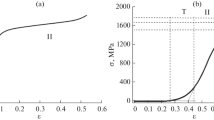Abstract
Methods of modern physical materials science are used to study the evolution of structural-phase states and dislocation substructure of rail steel under uniaxial compression deformation up to 50%. The revealed fragmentation of pearlite grains becomes more expressed with increasing deformation, and the fragmentation of cementite plates with the fragment size of 15–20 nm weakly depends on the degree of deformation. The change in the scalar and excess dislocation density with increasing deformation is analyzed. Sources of internal stress fields are identified and classified. The data obtained formed the basis for a quantitative analysis of the mechanisms of hardening of rail steel at degrees of compression deformation of 15, 30, and 50%. The contributions to strengthening caused by friction of the matrix lattice, dislocation substructure, fragment boundaries, carbide particles, internal stress fields, solid-solution strengthening, and the pearlite component of the steel structure are estimated. The primary mechanism of metal hardening at the deformation of 50% is hardening by incoherent particles and elastic internal stress fields. Using the additivity principle, which assumes the independent action of each of the hardening mechanisms, the dependence of the total yield strength of rail steel on the degree of compressive deformation is estimated.
Similar content being viewed by others
REFERENCES
V. V. Rybin, Large Plastic Deformations and Destruction of Metals (Metallurgiya, Moscow, 1986) [in Russian].
V. E. Gromov, E. V. Kozlov, V. I. Bazaikin, V. Ya. Tsellermaer, Yu. F. Ivanov, et al., Physics and Mechanics of Drawing and Forging (Nedra, Moscow, 1997) [in Russian].
V. E. Panin, V. A. Likhachev, and Yu. V. Grinyaev, Structural Levels of Deformation of Solids (Nauka, Novosibirsk, 1985) [in Russian].
D. Raabe and R. Kumar, Scr. Mater., No. 66, 634 (2012).
M. K. Skakov, G. K. Uazyrkhanova, N. A. Popova, and M. Scheffler, Key Eng. Mater. 531— 532, 13 (2013).
J. Zrnik, S. Dobatkin, G. Raab, M. Fujda, and L. Kraus, Rev. Mater. 15, 240 (2010).
R. Pan, R. Ren, C. Chen, and X. Zhao, Mater. Charact. 132, 397 (2017).
A. Vinogradov and Y. Estrin, Prog. Mater. Sci. 95, 172 (2018).
Yu. Ivanisenko, W. Lojkowski, R. Z. Valiev, and H.‑J. Fecht, Acta Mater. 51, 5555 (2003).
H. Yahyaoui, H. Sidhom, C. Braham, and A. Baczmanski, Mater. Des. 55, 888 (2014).
V. V. Veter, S. G. Zhuleikin, L. N. Ignatenko, V. V. Kovalenko, V. E. Gromov, N. A. Popova, and E. V. Kozlov, Izv. Akad. Nauk, Ser. Fiz. 67, 1375 (2003).
Y. Wang, Y. Tomota, S. Harjo, W. Gong, and T. Ohmuraa, Mater. Sci. Eng. A 676, 522 (2016).
Yu. F. Ivanov, V. E. Gromov, A. A. Yuriev, V. E. Kormyshev, Yu. A. Rubannikova, and A. P. Semin, J. Mater. Res. Technol. 11, 710 (2021).
A. A. Yuriev, Yu. F. Ivanov, V. E. Gromov, Yu. A. Rubannikova, M. D. Starostenkov, and P. Y. Tabakov, Structure and Properties of Lengthy Rails after Extreme Long-Term Operation (Mater. Res. Forum, Millersville, PA, 2021).
Yu. F. Ivanov, A. A. Yuriev, X. Chen, V. B. Kosterev, and V. E. Gromov, Izv. AltGU, Fiz., No. 1 (117), 33 (2021).
Yu. F. Ivanov, A. M. Glezer, R. V. Kuznetsov, V. E. Gromov, Yu. A. Shliarova, A. P. Semin, and R. V. Sundeev, Mater. Lett. 309, 131378 (2022).
V. E. Gromov, Yu. F. Ivanov, R. S. Qin, O. A. Peregudov, K. V. Aksenova, and O. A. Semina, Mater. Sci. Technol. 33, 1473 (2017).
V. E. Gromov, A. B. Yuriev, K. V. Morozov, and Y. F. Ivanov, Microstructure of Quenched Rails (ISP, Cambridge, 2016).
V. E. Gromov, A. A. Yuriev, O. A. Peregudov, S. V. Ko-novalov, Yu. F. Ivanov, A. M. Glezer, and A. P. Semin, AIP Conf. Proc. 1909, 020066 (2017).
Yu. F. Ivanov, V. E. Gromov, K. V. Aksenova, R. V. Kuznetsov, V. E. Kormyshev, and E. S. Vashchuk, Deform. Razrush. Mater., No. 8, 9 (2022).
K. V. Aksenova, V. E. Gromov, Yu. F. Ivanov, E. S. Vashchuk, and O. A. Peregudov, Izv. Vyssh. Uchebn. Zaved., Chern. Metall., No. 10, 43 (2022).
F. R. Egerton, Physical Principles of Electron Microscopy (Springer Int., Basel, 2016).
C. S. S. R. Kumar, Transmission Electron Microscopy. Characterization of Nanomaterials (Springer, New York, 2014).
C. B. Carter and D. B. Williams, Transmission Electron Microscopy (Springer Int., Berlin, 2016).
Electron Microscopy of Thin Crystals, Ed. by P. B. Hirsch, A. Howie, R. B. Nicholson, D. W. Pashley, and M. J. Whelan (Plenum, New York, 1965).
N. A. Koneva, D. V. Lychagin, L. A. Teplyakova, and E. V. Kozlov, in Experimental Study and Theoretical Description of Disclination (FTI, Leningrad, 1984), p. 161 [in Russian].
F. B. Pikering, Physical Metallurgy and Steel Processing (Metallurgiya, Moscow, 1982) [in Russian].
N. A. Koneva, S. F. Kiseleva, and N. A. Popova, Structure Evolution and Internal Stress Fields. Austenitic Steel (LAP Lambert Academic, Saarbrücken, 2017).
M. J. Yao, E. Welsch, D. Ponge, S. M. H. Haghighat, S. Sandlöbes, P. Choi, M. Herbig, I. Bleskov, T. Hickel, M. Lipinska-Chwalek, P. Shantraj, C. Scheu, S. Zaefferer, B. Gault, and D. Raabe, Acta Mater. 140, 258 (2017).
L. I. Tushinskii, A. A. Bataev, and L. B. Tikhomirova, Perlite Structure and Structural Strength of Steel (Nauka, Novosibirsk, 1993) [in Russian].
B. Z. Belen’kii, B. M. Farber, and M. I. Gol’dshtein, Fiz. Met. Metalloved. 39, 403 (1975).
H. Sieurin, J. Zander, and R. Sandström, Mater. Sci. Eng. A 415, 66 (2006).
T. Prnka, Metalloved. Term. Obrab. Stali., No. 7, 3 (1979).
ACKNOWLEDGMENTS
The authors are grateful to E.A. Polevoy, PhD (Eng.), for providing samples of rail steel and K.V. Aksenova, PhD (Eng.), for discussing the results.
Funding
The work was supported by the Russian Foundation for Basic Research (project no. 19-32-60001) and the RF Ministry of Science and Higher Education under the project under agreement no. 075-15-2021-709, project identifier RF-2296.61321Kh0037 (control measurements).
Author information
Authors and Affiliations
Corresponding author
Ethics declarations
The authors declare that they have no conflicts of interest.
Additional information
Translated by O. Zhukova
Rights and permissions
About this article
Cite this article
Popova, N.A., Gromov, V.E., Ivanov, Y.F. et al. Evaluation of the Mechanisms of Compression Hardening of Rail Steel. Phys. Solid State 64, 531–537 (2022). https://doi.org/10.1134/S1063783422110087
Received:
Revised:
Accepted:
Published:
Issue Date:
DOI: https://doi.org/10.1134/S1063783422110087




